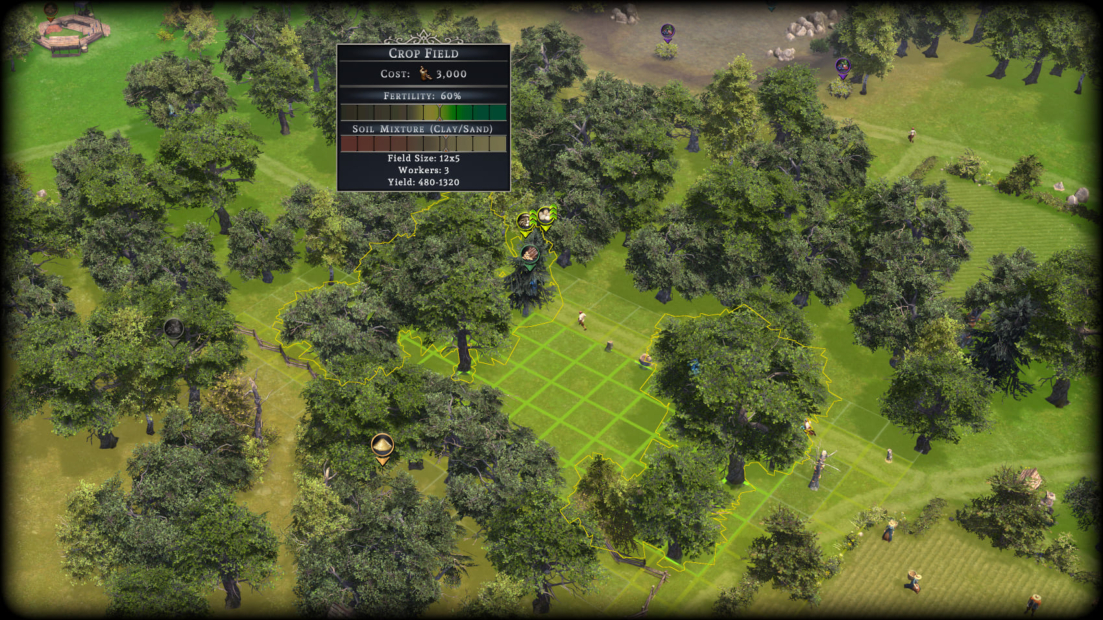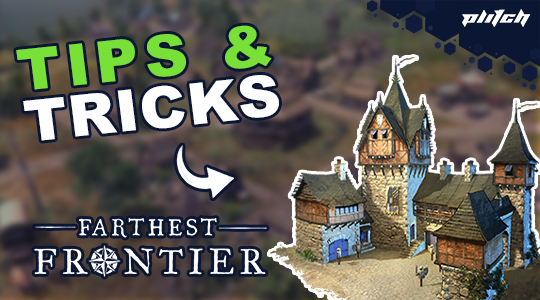In our Farthest Frontier farming guide, we’ll show you how to create profitable fields, protect yourself from crop failures, and make your agriculture flourish.
Table of Contents
How to Start a Productive Field
It’s best to begin with small fields in Farthest Frontier because they don’t take as long to set up. Additionally, their size isn’t fixed and can be adjusted anytime. From experience, we suggest starting with 3 to 4 fields. This way, you can grow different types of food simultaneously, and you won’t have issues with crop rotation.

With fewer fields, the risk of wild animals or plant diseases like mildew damaging your harvest is too high. The more fields you have, the better you can make up for such shortages.
Farthest Frontier Crop Rotation Guide
When it comes to crop rotation in Farthest Frontier, you can see how detailed and comprehensive the game’s simulation aspect is. Almost everything that impacts crop growth in the real world also influences it in Farthest Frontier. The season, temperature, diseases, and the right soil — everything must be considered. Let’s go through the process step by step.
A field is quickly planned: You click on “Food” and then simply drag the mouse over the map to the area you want to cultivate. The minimum size is 5×5 fields, and the maximum is 12×12. Then your workers start planting the field.

Depending on how level the ground is and the number of weeds and stones in the way, this could take some time. You should also ensure that your workers stop working when there’s frost on the ground during winter.
Once the process is finished, you can start planting in Farthest Frontier. First, choose the year when the plant will be sown. You don’t need to worry about the seeds. Your villagers have all kinds of seeds from the start. You can see the years at the top of the screen. I stands for the current year, II for the next, and III for the year after that.
After clicking on the respective year, you’ll see an overview of all plants on the right side. Hovering your cursor over a plant will display its needs, growth time, and other practical details. Clicking on a plant will add it to the year you’re working on. You can remove it at any time by clicking the red X.
On the three-year timeline, the growth period is also visually shown. The space the plant symbol takes up indicates how long the maturation process lasts. It should be noted that wheat and other cereals require a very long time, meaning you can’t grow them in the same year on one field. It’s best to plant beans or turnips in their fields.
Once chosen, the sowings will automatically repeat every 3 years. Adjustments become necessary when your settlers request new products or more complex foods, or when you expand your fields. You also need to monitor soil fertility and restore it regularly. But more about this in the next part of our Farthest Frontier farming guide.
How to Increase Soil Fertility
Choose the right location
The yield of your crop depends not only on weather conditions and disease prevention but also on the fertility of the land. Therefore, choose a location with good soil for your fields. The fertility bonus in Farthest Frontier is shown as an overlay on the map when you move the fields.
Certain plants
Some plants enhance soil quality. These include clover, peas, and beans. Clover has the most significant effect, but you can’t sell or eat it. However, if one of your fields has severely poor soil fertility, it’s worth allowing a period of clover to grow there. After all, even peas and beans don’t grow well in poor-quality soil.
Build a compost yard
A compost yard is also helpful for farming in Farthest Frontier. After all, your city continuously generates waste that you can use as fertilizer. It’s best to build one near your farmers’ buildings early on, assign a resident as a waste collector, and then select the field you want to fertilize once a year.
Clay and sand
The soil mixture also influences the yield of your fields. Some crops thrive in clay, while others prefer sand. Adding the appropriate material can boost your yield by 10%.
Meadows
Cows also positively impact the land. Allowing your cattle to graze in a meadow for some time makes it reasonable to cultivate fields there later. As a result, the soil will be highly fertile from the start.
💡 Tip: Also check out our Farthest Frontier beginner tips and tricks!
Farthest Frontier Farming Guide: Other Tips and Tricks
Watch out for rocks and weeds
Field maintenance is essential for sustainable farming in Farthest Frontier. If you just started your field, you’ll likely need to perform it several times a year. This involves removing rocks and weeds so your vegetables can grow properly. Over time, the frequency of maintenance will decrease, and you’ll only need to send someone out every few years. You can choose the maintenance interval by clicking on the farmer icon.
Build fences, walls, and gates
Wild animals and scavengers can greatly reduce your harvest. While you protect yourself from hungry wildlife with wooden fences, you need to build stone walls to keep out human thieves. For your farmers to keep working, you also need gates.

At the start of the game, place wooden fences around each field right away. Later, upgrade them once you have enough stones.
Pay attention to harvest time and storage
Every crop can spoil. Therefore, it’s important to stagger harvest times so that ripe fruits don’t have to wait too long to be picked. But it’s not just in the field where vegetables can go moldy; products also don’t last forever in storage. Cabbage and leeks spoil the fastest and should be eaten quickly. Beans and carrots, however, last longer and shouldn’t be kept for too long.
The Best Plants in Farthest Frontier
- Make sure to include turnips in at least one of your fields to start. They are quick and easy to grow, resist various weather conditions, and can be harvested multiple times a year.
- Peas help you earn money while improving soil fertility. Since cold doesn’t kill them, but heat does, you shouldn’t grow them in the summer. However, they are a good choice in other seasons.
- Beans also boost fertility but cost less than peas. However, they spoil more slowly.
- Carrots, as mentioned earlier, also have a longer shelf life in Farthest Frontier. However, you should only let them grow in well-maintained fields, as stones can severely hinder their growth. Frost, on the other hand, does not affect them.
- Buckwheat is a versatile plant with many requirements. In return, it has a shorter growing season than other grains, is heat-resistant, and can also suppress weeds.
- Clover is used to restore soil fertility. You won’t earn money from it, nor can you eat it. Still, it’s part of a well-planned crop rotation and should be grown between two periods of nutrient-heavy crops, such as flax.
- Said flax reduces fertility but is essential for tailoring. It’s used to produce linen, which is ultimately transformed into clothing.
- Cabbage has the advantage that it doesn’t mind the weather. Whether cold or warm, it always thrives unless the soil quality is poor. In this regard, the vegetable, which can only be kept for a short time, turns out to be quite picky.
- Leek has a similarly long growth period as cereals, but is resistant to temperature changes. Although it can be grown year-round, we recommend avoiding overproduction because of its moderate shelf life.
- Wheat is demanding. It requires fertile soil and can be susceptible to diseases, but it has a long shelf life and is also essential if you want to make flour or beer.
- Rye is less demanding on its environment, both in terms of soil and temperature. However, it yields less than wheat.
Level Up Your Farming With PLITCH!
Our Farthest Frontier farming guide will have your cash register ringing in no time. After all, farming is a profitable business in the game.
To help your crops grow faster, PLITCH’s Farthest Frontier cheats offer many ways to increase yields. For example, you can boost game speed to accelerate cycles or adjust the time to reach the ideal planting month.
You can also influence the production and storage of goods with our codes. So, if bad weather, nasty looters, or pesky diseases get you down, you don’t have to start a new game; you can simply adjust your run accordingly.
Check out this blog and our YouTube channel to learn more about PLITCH and our codes!
Happy Gaming!

